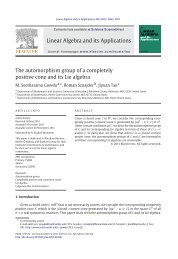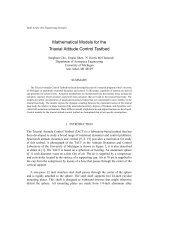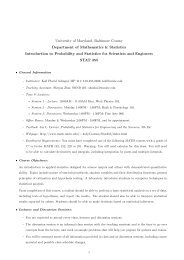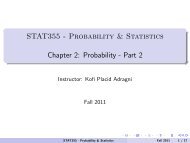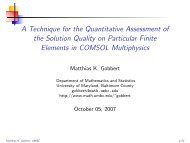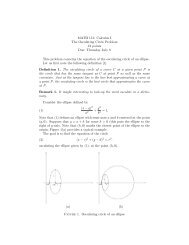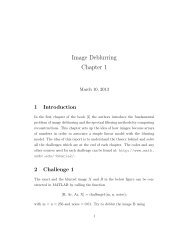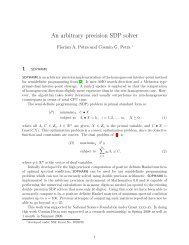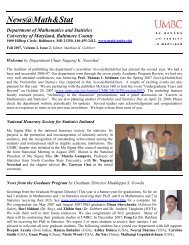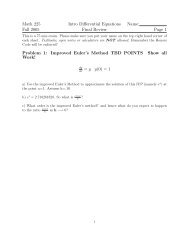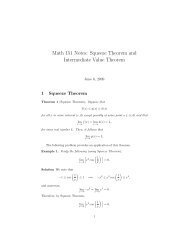inverse and implicit function theorems for h-differentiable and ...
inverse and implicit function theorems for h-differentiable and ...
inverse and implicit function theorems for h-differentiable and ...
- No tags were found...
You also want an ePaper? Increase the reach of your titles
YUMPU automatically turns print PDFs into web optimized ePapers that Google loves.
444 M. S. GOWDAsimilar results. In 1991, Robinson [44] proved an <strong>implicit</strong> <strong>function</strong> theorem <strong>for</strong> nonsmooth<strong>function</strong>s based on the concept of strong approximation <strong>and</strong> on a certain (numerical) measure ofLipschitzian invertibility. In 1991, Kummer [25] gave a characterization of (local) Lipschitzianinvertibility of a <strong>function</strong>. He showed that a locally Lipschitzian <strong>function</strong> f : R n → R n is Lipschitzianinvertible at a point x ∗ if <strong>and</strong> only if 0 /∈ f (x ∗ ,d) <strong>for</strong> all 0 ̸= d ∈ R n , wheref (x ∗ ,d) consists of all limit points of sequences of the <strong>for</strong>m λ −1k [f(xk + λ k d) − f(x k )]with x k → x ∗ <strong>and</strong> λ k ↓ 0. Since the technical assumptions in these works rely on analyticalquantities <strong>and</strong>/or approximations, we shall refer to these results as analytical <strong>inverse</strong>/<strong>implicit</strong><strong>function</strong> <strong>theorems</strong>. Furthermore, the proofs in these works are based on fixed point <strong>theorems</strong><strong>and</strong>/or optimality conditions <strong>for</strong> minimization problems. In contrast to these, our results inthis article are algebraic in nature <strong>and</strong> rely on topological degree theory. In a rough sense, theysay the following: If(a) f : R n → R n is continuous in a neighborhood of a point x ∗ ,(b) a certain set of n × n matrices associated with f are coherently oriented (i.e., they havethe same nonzero determinantal sign), <strong>and</strong>(c) the (topological) index of f at x ∗ is ±1,then f is locally invertible at x ∗ with the <strong>inverse</strong> enjoying certain properties that are similar tothose of f .To motivate our results, we begin with the linear complementarity problem LCP(M,q) [7]of finding a vector x in R n such thatx ≥ 0, y = Mx + q ≥ 0, <strong>and</strong> 〈x,y〉=0,where M ∈ R n×n <strong>and</strong> q ∈ R n . In this context, it is well known [24,30,48] that thepiecewise affine <strong>function</strong> f(x):= Mx + − x − , where x + = max{x,0} <strong>and</strong> x − := x + − x, islocally invertible at the origin (equivalently, globally invertible on R n ) if <strong>and</strong> only if the matricesthat describe f are coherently oriented. (This translates to the P-property of M, namely, allthe principal minors of M are positive.) Generalizing this, Robinson [45] has shown that <strong>for</strong>an affine variational inequality problem AVI(M,K,q), where M ∈ R n×n ,q ∈ R n , <strong>and</strong> K is apolyhedral convex set in R n , the (piecewise affine) normal mapf(x):= M( K (x)) + x − K (x),where K (x) denotes the projection of x onto K, is globally invertible on R n if <strong>and</strong> only if thematrices describing f are coherently oriented. Motivated by applications to electrical networks,optimization, etc., various researchers have studied the global homeomorphism properties ofpiecewise affine mappings; see, e.g., Refs. [3,14,23,24,31,49,50], etc. These global results canbe localized to yield local inversion <strong>theorems</strong> <strong>for</strong> piecewise affine <strong>function</strong>s. For example, thelocal version of a result [Theorem 4.5, Ref. 14] says that a piecewise affine <strong>function</strong> fromR n to itself is locally invertible at a point if <strong>and</strong> only if the matrices describing the <strong>function</strong>at that point are coherently oriented <strong>and</strong> the topological index of the <strong>function</strong> at that pointis ±1. In 1996, Pang <strong>and</strong> Ralph [35] described a generalization of this to piecewise smooth(PC 1 ) <strong>function</strong>s. In that paper, it was shown that if at the point under consideration, the socalledBoulig<strong>and</strong> (sub)differential of the <strong>function</strong> is coherently oriented <strong>and</strong> if the index of the<strong>function</strong> is ±1, then the <strong>function</strong> is locally invertible with an <strong>inverse</strong> that is piecewise smooth;see Ref. [27] <strong>for</strong> a related <strong>implicit</strong> <strong>function</strong> theorem, <strong>and</strong> Ref. [43] <strong>for</strong> <strong>inverse</strong>/<strong>implicit</strong> <strong>function</strong><strong>theorems</strong> <strong>for</strong> PC r <strong>function</strong>s.In recent times, a class of <strong>function</strong>s called semismooth <strong>function</strong>s have attracted a lot ofattention in the optimization community; see, <strong>for</strong> example, Refs. [28,34,39,42] <strong>and</strong> Section 2.3




